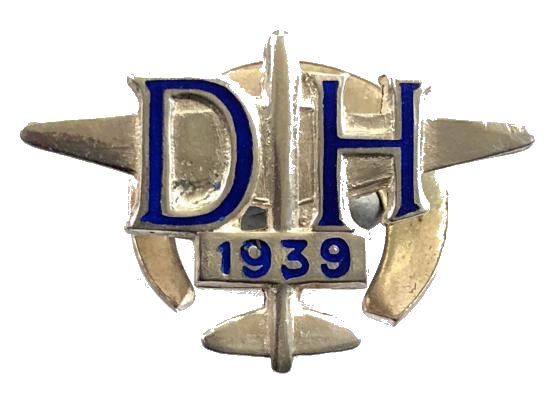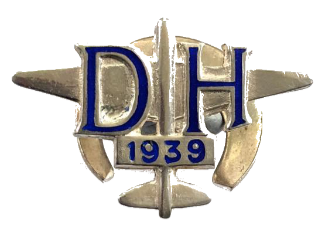de Havilland
DH.110 Sea Vixen
|
|||||||||||||||||||||||
|
|
|---|
.
History de Havilland Aircraft Company
de Havilland DH.110 Sea Vixen
Introduction date July 1959 First flight 26 September 1951

The de Havilland DH.110 Sea Vixen is a British twin-engine, twin boom-tailed, two-seat, carrier-based fleet air-defence fighter flown by the Royal Navy's Fleet Air Arm from the 1950s to the early 1970s. The Sea Vixen was designed by the de Havilland Aircraft Company during the late 1940s at its Hatfield aircraft factory in Hertfordshire, developed from the company's earlier first generation jet fighters. It was later called the Hawker Siddeley Sea Vixen after de Havilland was absorbed by the Hawker Siddeley Corporation in 1960.
Design

The Sea Vixen had the distinction of being the first British two-seat combat aircraft to achieve supersonic speed, albeit not in level flight. Operating from British aircraft carriers, it was used in combat over Tanganyika and over Yemen during the Aden Emergency. In 1972, the Sea Vixen was phased out in favour of the American-made McDonnell Douglas Phantom FG.1 interceptor. There have been no flying Sea Vixens since 2017.
Design

The de Havilland Sea Vixen was a jet-powered fleet defence fighter, equipped with a modern radar and air-to-air missiles for its primary role. When it entered service, it was the first British aircraft to be solely armed with missiles, rockets and bombs; this made it the first fighter aircraft operated by the Fleet Air Arm with no gun armament. The Sea Vixen FAW.1 was armed with four de Havilland Firestreak air-to-air missiles, while the Sea Vixen FAW.2 could also carry the later, more capable Red Top missile. The original DH.110 design offered to the RAF was armed with four cannon before soon being replaced with an all-missile armament. The Red Top homing head was pointed in the direction of the target by slaving it to the AI18 radar, which was operated by the observer.
0
KmCeiling
0
KmCombat RANGE
0
MachAircraft Speed
0
Max Crew
Photo Gallery
de Havilland Aircraft Company
de Havilland DH.110 Sea Vixen
Introduction date July 1959
First flight 26 September 1951


de Havilland Aircraft Company
de Havilland DH.110 Sea Vixen
Introduction date July 1959 First flight 26 September 1951
General Info
-
-
-
- Crew: 2
- Length: 55 ft 7 in (16.94 m)
- Wingspan: 51 ft 0 in (15.54 m)
- Height: 10 ft 9 in (3.28 m)
- Wing area: 648 sq ft (60.2 m2)
-
-
Powerplant
-
-
- Empty weight: 27,950 lb (12,678 kg)
- Gross weight: 41,575 lb (18,858 kg)
- Max takeoff weight: 46,750 lb (21,205 kg)
- Powerplant: 2 × Rolls-Royce Avon 208 turbojet engines, 11,000 lbf (49 kN) thrust each
-
Performance
-
- Maximum speed: 690 mph (1,110 km/h, 600 kn)
- Maximum speed: Mach 0.91
- Range: 790 mi (1,270 km, 690 nmi) on internals
- Service ceiling: 48,000 ft (15,000 m)
- Rate of climb: 9,000 ft/min (46 m/s)
Armament
-
-
- Hardpoints: 6 , with provisions to carry combinations of:
- Rockets: 4 Matra rocket pods with 18 SNEB 68 mm rockets each, or 4 Rocket pods with 24 or 32 Microcell 2-inch rockets. or 24 3-inch rockets,
- Missiles: 4 Red Top or Firestreak air-to-air missiles, 2 AGM-12 Bullpup air-to-ground missiles
- Bombs: 1 Red Beard freefall nuclear bomb, or four 500 lb (227 kg) or two 1,000 lb (454 kg) conventional bombs.
- Hardpoints: 6 , with provisions to carry combinations of:
-
Links to Youtube & Others
In 2013, the FAA modified its rules to prohibit the operation of jets weighing 75,000 pounds (34,000 kg) or less that are not stage 3 noise compliant, specifically mentioning the 125 series of aircraft. This required any aircraft of the type either to have compliant engines installed, or to be fitted with a hush kit, to fly over most of the United States after 31 December 2015
de Havilland
DH.110 Sea Vixen
In 1961, de Havilland began work upon a small business jet, then known as the DH.125 Jet Dragon.
Youtube Link
The aircraft went through many designation changes during its service life. Hawker Siddeley had bought de Havilland the year before the project had started, but the legacy brand and "DH" designation.














.svg.png)